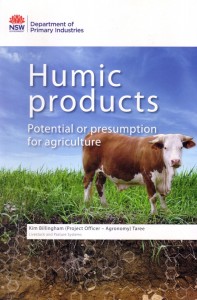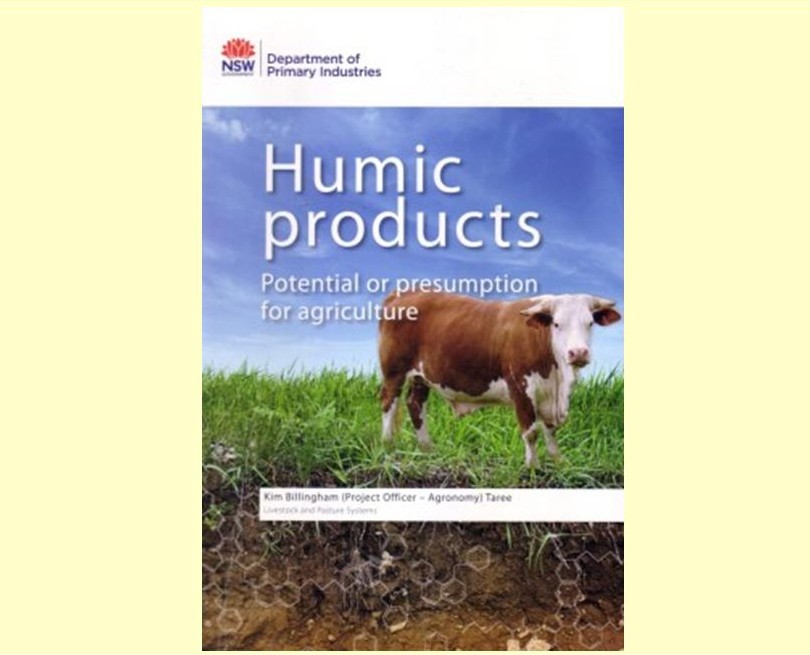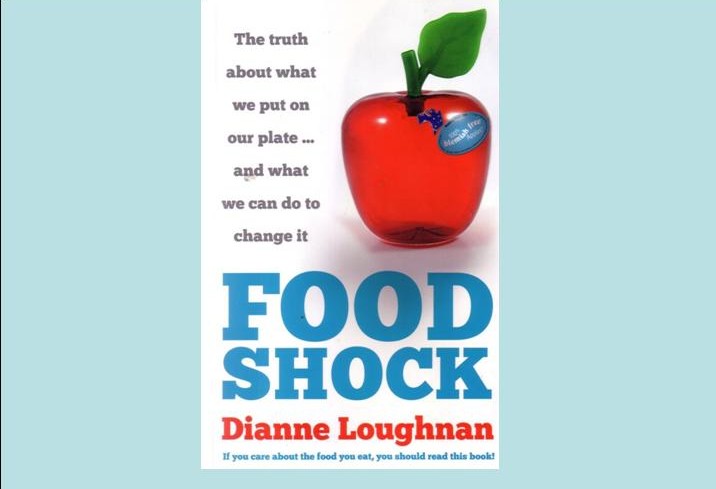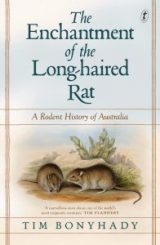Humic products – potential or presumption for agriculture
Review by Patrick Francis
It has been a long time coming, but finally a department of primary industries has taken on the mantle of assessing the practical value of commonly promoted biological products. The move over the last decade by an increasing number of conventional input farmers to embrace soil health improvement is a welcome development. But with it has come a massive increase in the range of commercial biological products advocated by their manufacturers or sellers to boost pasture and crop yield through better soil health.
 For organic or biological farmers routine use of natural fertilisers, soil ameliorants and biology enhancers is part of their annual input routine, they are reasonably familiar with the products and believe in their value. But for conventional input farmers who have traditionally cropped with chemical based fertilisers the biological products are an unknown quantity. Claims made by their retailers that use of biological products can reduce chemical fertiliser requirements and at the same time boost yields and profits are eye catching and alluring when grain and livestock gross margins are declining.
For organic or biological farmers routine use of natural fertilisers, soil ameliorants and biology enhancers is part of their annual input routine, they are reasonably familiar with the products and believe in their value. But for conventional input farmers who have traditionally cropped with chemical based fertilisers the biological products are an unknown quantity. Claims made by their retailers that use of biological products can reduce chemical fertiliser requirements and at the same time boost yields and profits are eye catching and alluring when grain and livestock gross margins are declining.
The problem with biological product claims is twofold, firstly they have not been thoroughly tested in broadacre, dryland farming in Australia, and secondly the natural or background levels of biological components in many Australian soil is not particularly well known. This lack of knowledge is exacerbated by the wide range of different soil types within a farm, within a district as well as the impacts of highly variable rainfall.
Recognising all these issues Kim Billingham a NSW DPI agronomist at Taree took on the challenge of investigating one group of commonly promoted biological ameliorants – humic products. In an exceptionally well written and comprehensive review Billingham provides the reader with as much information as is available to make an informed decision about whether of not humic products are likely to make an improvement to soil health and lift yields and profitability at the same time.
The book starts with an enlightening brief history of humus and humic substances. It then describes humic products and provides details about Australian companies selling the products.
“An extensive web search …in February 2012 uncovered 28 different Australian companies selling more than 200 humic products with a wide use of terms and trade names.”
Details Billingham found about the companies and products is disturbing, it included:
- Only six companies provided information about the timing and frequency of product applications.
- Two distributors had granular products listed from $2.60/kilogram to $7.80/kg; liquid products were listed from $7/litre to $18/l.
- Three companies referred to trial results relating to their products but full details were not given.
- Only two companies attempted a detailed scientific explanation for the structure and function of humic substances.
- All companies made claims about their products such as increased water holding capacity, improved soil wetting, promotion of good soil structure, increased porosity of soil, increased cation exchange capacity, improved nitrogen efficiency, complexation of phosphorus, promotion of seed germination, increased microbial and enzyme activity, improved yield and drought tolerance and better plant disease resistance.
When Billingham analysed all the information she found uncertainty existed even about what humic substances are.
“Many organic substances satisfy the functional definition of a humic acid … yet cannot be classed as humic substances. Furthermore the fraction isolated in laboratories such as humic acids, fulvic acids and humins may not even exist naturally in soils and according to one research team may not be relevant to soil processes.”
One of the most important issue for farmers deciding on using humic products or not is to know what the natural level is in their soil. Billingham says the average topsoil in Australia contains 17 tonnes of humic substances per hectare and sandy soil with low organic matter about 5 t/ha. More details about the range in different soil types are not provided and would have been useful.
She says in soils with average humic substance content, applications of humate granules at a commonly recommended rate of 50 kg/ha represents only a 0.3% increase.
“This could only be viable if the humates were banded into the soil or combined chemically or physically with nutrients which they made more available.”
With liquid or foliar sprays, the dilution rate is even higher so the amount of humic products entering the soil would be negligible. Another related issue is that there is no method of separating non-humic material from humic in products. The companies advertised humic concentrations in their products from 12% to 85% and fulvic acids as low as 0.16%.
“This lowers the amount of humic material being applied even more, relative to the quantity of humic substances naturally occurring in the soil.”
Billingham contends that natural humates would have to be broadcast at 200kg to 1000kg/ha to have any likely benefits.
“However, at a price exceeding $2000/tonne are there more cost effective ways of improving the soil, for example mulching with compost?”
Most pages in the book are devoted to analysis of claims made about the products. This starts with a comprehensive review of the scientific literature with trials going back as far as 1970. She finds there is evidence that both humic substances in soil and amendments with humic products can promote plant growth by both direct and indirect means, but the data is mostly associated with pot trials often in soil free media, and with fruits and vegetables, not cereal crops and pastures.
The claims investigated are for soil structure, water holding capacity, pH buffer, cation exchange capacity, nitrogen, phosphorus, metal complexes and chelates, remediation of soil contamination, and biological properties. Under each heading she covers background, product claims, how does it work, what’s the evidence, and potential or presumption. This leaves the reader in the clear position to decide on the veracity of claimed benefits.
Billingham concludes, “there may be a role for humic products in agriculture under particular circumstances. The most promising related to availability of phosphorus and micronutrients and …their role in soil remediation. Independent trials are needed to ascertain the conditions and application rates that would benefit plant growth economically.”
She points out that there a plenty soil and farm management conditions where humic products are unlikely to be of benefit, these include:
- soils with organic matter over 5%
- where optimum fertility and growing conditions exist
- where composts or manures are being applied
- where other biological stimulants are used such as growth hormones or seaweed.
Billingham believes independent Australian research needs to be undertaken on humic and other biological products across the range of major crops grown.
“If the work is not done and evidence-based recommendations are not made, sales of humic products will blossom and products will be used in inappropriate situations at ineffective rates. Crop responses will be varied or non-existent and humic products will fade away as yet another alternative fad. The potential of these products will not be realised and in another 30 or 40 years or so, the cycle will repeat itself.
“Humic products: Potential or presumption for agriculture” is highly recommended for all farmers interested in soil health improvement.
Find out more:
To obtain a copy of the book contact Kim Billingham kim.billingham@dpi.nsw.gov.au



